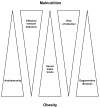Leptin and Inflammation
- PMID: 20198122
- PMCID: PMC2829991
- DOI: 10.2174/157339508784325046
Leptin and Inflammation
Abstract
The past few years of research on leptin have provided important information on the link between metabolism and immune homeostasis. Adipocytes influence not only the endocrine system but also the immune response through several cytokine-like mediators known as adipokines, which include leptin. It is widely accepted that leptin can directly link nutritional status and pro-inflammatory T helper 1 immune responses, and that a decrease of leptin plasma concentration during food deprivation can lead to an impaired immune function. Additionally, several studies have implicated leptin in the pathogenesis of chronic inflammation, and the elevated circulating leptin levels in obesity appear to contribute to the low-grade inflammatory background which makes obese individuals more susceptible to increased risk of developing cardiovascular diseases, type II diabetes, or degenerative disease including autoimmunity and cancer. Conversely, reduced levels of leptin such as those found in malnourished individuals have been linked to increased risk of infection and reduced cell-mediated immune responses. We discuss here the functional influences of leptin in the physiopathology of inflammation, and the effects of leptin in the modulation of such responses.
Conflict of interest statement
The authors declare no conflict of interests.
Figures



References
-
- Zhang Y, Proenca R, Maffei M, Barone M, Leopold L, Friedman JM. Positional cloning of the mouse obese gene and its human homologue. Nature. 1994;372:425–32. - PubMed
-
- Considine RV, Sinha MK, Heiman ML, et al. Serum immunoreactive-leptin concentrations in normal-weight and obese humans. N Engl J Med. 1996;334:292–5. - PubMed
-
- Frederich RC, Hamann A, Anderson S, Löllmann B, Lowell BB, Flier JS. Leptin levels reflect body lipid content in mice: evidence for diet-induced resistance to leptin action. Nat Med. 1995;1:1311–4. - PubMed
-
- Maffei M, Halaas J, Ravussin E, et al. Leptin levels in human and rodent: measurement of plasma leptin and ob RNA in obese and weight-reduced subjects. Nat Med. 1995;1:1155–61. - PubMed
Grants and funding
LinkOut - more resources
Full Text Sources
Other Literature Sources
Medical
Miscellaneous
